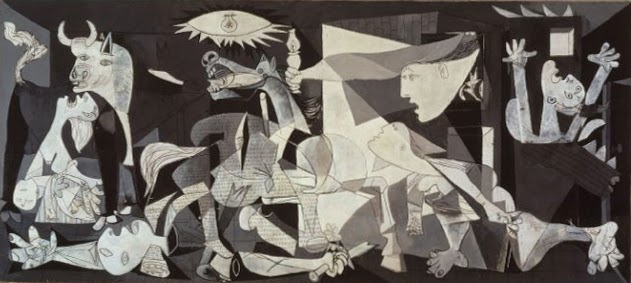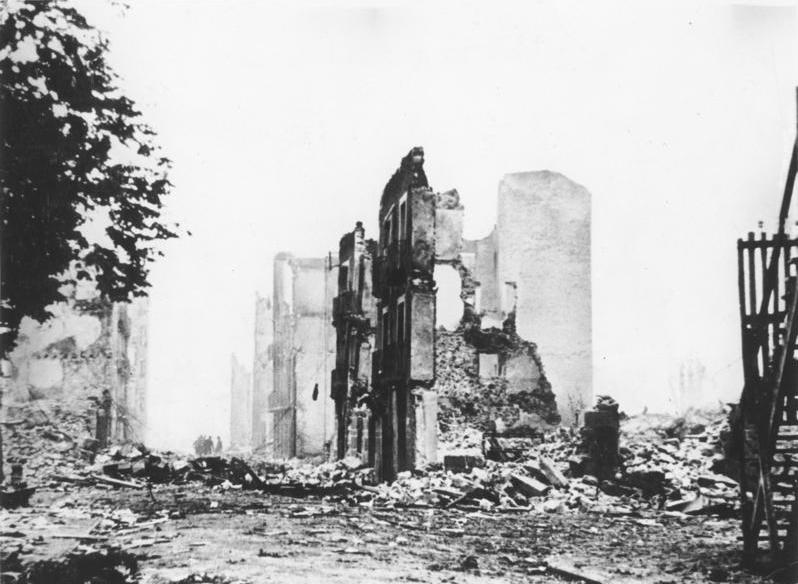
Pablo Picasso’s Guernica, 1937, Museo Reina Sofia, Madrid, Spain
On July 12, 1937, Pablo Picasso presents his famous painting Guernica for the very first time at the Spanish Pavilion at the Paris International Exposition. It was created in response to the bombing of Guernica, a Basque Country village in northern Spain, by German and Italian warplanes at the behest of the Spanish Nationalist forces on 26 April 1937 during the Spanish Civil War. Guernica has become one of today’s most famous pieces of art.
I’m sure you have already some reproduction of Picasso’s Guernica somewhere. I remember there was a picture of it also in one of the textbooks we used for German classes back in school. Of course it is an impressive piece of modern art, but what makes it so special is of course the history that is connected with it. We already had an article about Pablo Picasso, one of the most influential artists of the 20th century.
The little town of Guernica
The little town of Guernica, which is the name giver for the picture, is a Basque Country village in northern Spain. It was in the 1930s during the Spanish Civil war, when on April 26, 1937, an aerial attack was carried out by planes of the German Luftwaffe “Condor Legion” and the Italian Fascist supporting the Nationalist forces of General Franco during the Spanish Civil War. The bombing caused widespread destruction and numerous civilian deaths. According to official Basque figures, 1,654 civilians were killed. The raid was requested by Francisco Franco to aid in his overthrowing the Basque Government and the Spanish Republican government. The town was devastated, though the Biscayan assembly and the Oak of Guernica survived. The Bombing of Guernica, that went on continuously for three hours, is considered to be the beginning of the Luftwaffe doctrine of terror bombing, where civilian targets were selected to demoralize the enemy. The bombing shocked and inspired many artists, among them the most famous Pablo Picasso.[4] By the time, Picasso was living in Paris. He had last visited his home country Spain in 1934 and would never return.

Guernica in ruins, 1937
The painting
In January 1937, Picasso was originally commissioned by the Spanish Republican government to create a large mural for the Spanish display at the 1937 World’s Fair in Paris. However, it was only on May 1, having read an eyewitness account by Times journalist George Steer that he abandoned his initial project and started sketching a series of preliminary drawings for the mural-size painting, which he would finish in early June 1937. Guernica is completely colored in grey, black and white, and it is a huge painting, 3.5 meters high and 7.8 meters wide painted in oil. In total, Picasso had to work on a picture surface of more than 27 square meters. A further difficulty was the ratio of the horizontal to the vertical: The width measures more than twice the height. Such a ratio is particularly suitable for a sequence of upright picture motifs, while Picasso wanted to create a scene of destruction with collapsing forms and reclining figures. The painting shows suffering people, animals, and buildings wrenched by violence and chaos. But as a rule, a picture tells more than a thousand words. You should simply click on the image above and have a look for yourself.
What does it mean?
There is this interesting story, that while living in Nazi-occupied Paris during World War II, one German officer allegedly asked Picasso, upon seeing a photo of Guernica in his apartment, “Did you do that?” Picasso responded, “No, you did.” Interpretations of Guernica vary widely and contradict one another. Therefore, we will spare you a debate about art criticism. When pressed to explain his thoughts and intentions expressed in Guernica, Picasso said:
“…this bull is a bull and this horse is a horse… If you give a meaning to certain things in my paintings it may be very true, but it is not my idea to give this meaning. What ideas and conclusions you have got I obtained too, but instinctively, unconsciously. I make the painting for the painting. I paint the objects for what they are.”
After the exhibition at the 1937 World’s Fair, the San Francisco Museum of Art gave the work its first public, free appearance in the United States in 1939, then it moved to the Museum of Modern Art in New York City. The painting traveled extensively in the United States; between 1953 and 1956 it was shown in Brazil, at the first-ever Picasso retrospective in Milan, Italy, and then in numerous other major European cities, before returning to MoMA for a retrospective celebrating Picasso’s seventy-fifth birthday. Under great pressure from a number of observers, MoMA finally ceded the painting to Spain in 1981. It first came to the Prado in Madrid and is since 1992 in the rooms of the Museo Reina Sofía, also in Madrid. In order to avoid irreparable damages, it must not be borrowed any more
The contemporary press largely rejected Guernica. One important exception was the prestigious art magazine Cahiers d’Art, which dedicated a double issue to Picasso. Paul Éluard, with whom Picasso was a close friend, wrote the poem The Victory of Guernica in 1938, in which he took up motifs from the painting. Éluard also worked with Alain Resnais to produce his thirteen-minute short film documentary Guernica in 1950.
Guernica has become a cultural icon that speaks to mankind not only against war but also of hope and peace.
T.J. Clark on Picasso’s ‘Guernica’, [9]
References and Further Reading:
- [1] a zoomable version of Guernica
- [2] Picasso’s “Secret” Guernica
- [3] The legacy of Guernica, BBC
- [4] Pablo Picasso – A Giant in Art, SciHi Blog
- [5] Guardian: Picasso’s Guernica Battle Lives On 26 April 2007
- [6] The New Yorker: Spanish Lessons, Picasso in Madrid by Peter Schjeldahl, 19 June 2006
- [7] Art Opposes Injustice! – Picasso’s Guernica: For Life by Dorothy Koppelman
- [8] Pablo Picasso at Wikidata
- [9] T.J. Clark on Picasso’s ‘Guernica’, 20154, London Review of Books (LRB) @ youtube
- [10] Saul, Toby (8 May 2018). “The horrible inspiration behind one of Picasso’s great works”. nationalgeographic.com.
- [11] Escalona, Alejandro. 75 years of Picasso’s Guernica: An Inconvenient Masterpiece, The Huffington Post, 23 May 2012.
- [12] Hensbergen, Gijs van. (2009) “Piecing together Guernica“. BBC News Magazine: 7 April 2009
- [13] Timeline of Picasso via Wikidata





